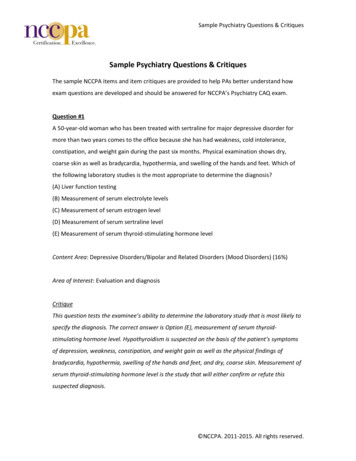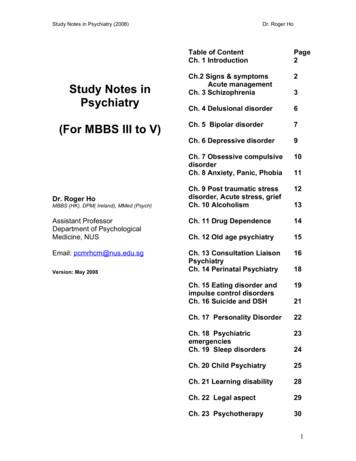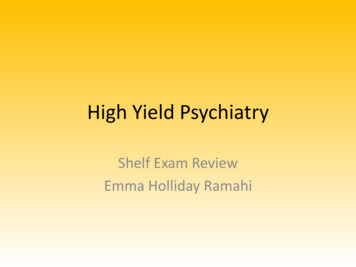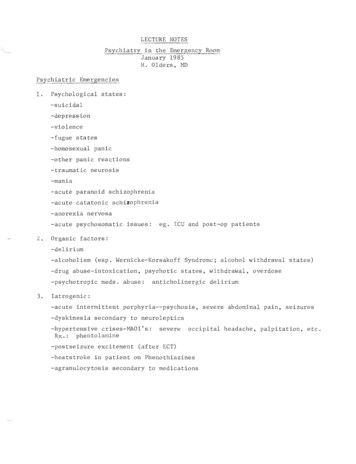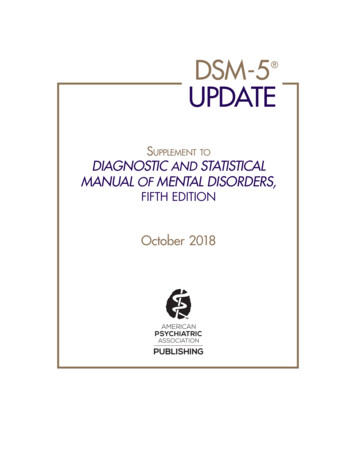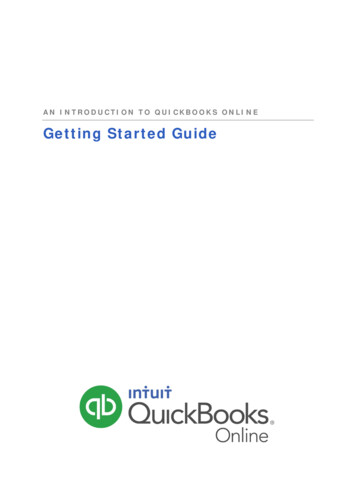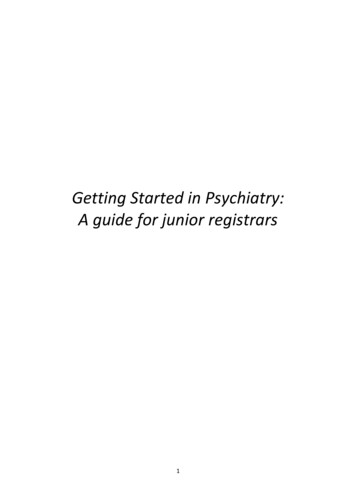
Transcription
Getting Started in Psychiatry:A guide for junior registrars1
IntroductionGetting started in psychiatry can seem daunting to begin with. However, the general principles ofpsychiatry are much the same as with the rest of medicine, and a strong grounding in generalmedicine is very important to the practice of psychiatry.That said, there are processes that are unique to psychiatry, including how we assess patients, aneed to understand the legal context to our work, and a focus on psychological factors that help usunderstand our patients in a broader way.The purpose of this handbook is to give you an overview of these processes. I have added numerousclinical examples to help make theory relevant to practice. Gaining experience in applying theseprinciples will inevitably come with time, as you see more patients, learn from their experiences, aswell as from your consultants.This handbook is intended to be an introduction to psychiatry, and it is important to read morewidely to increase your breadth of understanding of various topics relevant to psychiatry. I haveincluded some references and recommended readings at the end of each section. It is particularlyimportant that you familiarise yourself with the various RANZCP clinical practice guidelines.After learning the key principles outlined in this handbook I think that you will be in a good positionto start working on the afterhours roster, although I recommend doing a few “buddy shifts” withmore experienced registrars first.During your training, you will inevitably encounter situations where you are not sure what to do. Themost important thing to remember is that if you need help, then you should ask for it, even if youthink the question is “silly”.Speak to your consultant on the ward, or call the on‐call consultant if you find yourself not sure ofwhat to do. No‐one expects you to know everything, and it is better to ask for help rather than doingsomething which may not be the best thing for the patient. It is also not healthy for you to go homeat the end of a working day worrying about whether you did the right thing or not.I wrote this handbook whilst an advanced trainee transitioning into the role as a consultant atBlacktown Hospital, and I hope that you find it to be a useful resource.I would like to gratefully acknowledge Dr Greg De Moore, Dr Anu Kataria, and Dr Chris Ryan for theirassistance and support during the development of this handbook.Please feel free to email me with any corrections or suggestions to assist with any future revisions ofthis handbook.Dr Varun KumarStaff Specialist PsychiatristBlacktown/Mt Druitt HospitalsSydney West and Greater Southern Psychiatry Training NetworkVarun.Kumar@health.nsw.gov.au2
Table of Contents1. The language of psychiatryThis chapter will introduce you to the signs and symptoms of psychiatric illnesses.2. Introduction to psychiatric disordersThis chapter will give an overview of the major psychiatric disorders, with a focus onthe “diagnostic hierarchy”.3. The psychiatric historyThis chapter will teach you how to take a psychiatric history, and cover some basiccommunication skills which can be useful when taking a history.4. The mental state examThis chapter will give you an idea of how to do a mental state exam, and will providesome examples.5. The formulationThis chapter begins by discussing some important theories that allow us toconceptualise a patient’s presentation, and then discusses how to formulate a case.6. An approach to after‐hours shiftsThis chapter will give you an idea of what to expect during afterhours shifts, as wellas some tips on how to manage them. It will also discuss the NSW Mental Health Act,as well as the principles of capacity and substitute decision making.7. Managing psychiatric disordersThis chapter will cover the basics of managing individual psychiatric disorders,including biological, psychological, and social interventions.3
Chapter 1: The language of psychiatryWhy is it important to know the language of psychiatry?When we all started studying medicine, we were, in many ways learning a new language. Eachspecialty of medicine has its own specific language.For instance, there are some core terms needed to practice cardiology. These include terms like: Dyspnoea Orthopnoea Paroxysmal nocturnal dyspnoea Arrhythmia Acute coronary syndrome .and so onIt would be very difficult to assess and treat someone’s heart failure without knowing the languageof cardiology.Psychiatry itself has its own language. This language includes:1. Terms that we use to define “what we hear” during an interview with a patiento For example, when we hear about a patient’s delusions, the disorganisation of theirspeech (thought disorder), or when they describe to us the content of theirhallucinations.2. There are also terms that we use to describe “what we saw” during an interview with apatiento For instance, when we look at a patient’s facial expressions (affect), if there are anychanges in movements related to their mental state (psychomotor changes), or ifthey seem to be hallucinating despite the patient denying this (responding tointernal stimuli)In psychiatry, the difference between signs and symptoms can be a bit blurred, as many of ourpatient’s do not recognise they are mentally ill. For instance, few patients will present to hospitalstating that they have delusions.Knowing the language of psychiatry allows us to describe the symptoms a patient presents with, aswell as describe what signs you observed when you assessed the patient. Together, these are majorcomponents of the mental state exam, which assists us in diagnosing our patients.What do people mean when they say phenomenology?You will hear your consultants talk about “phenomenology”, and by this they mean the terms thatwe use in psychiatry to describe a patient’s direct experience. These terms make up the language ofpsychiatry.It is particularly important in psychiatry to know these terms well, as they are the primary meansthat we use to diagnose our patients. There are no blood tests or neuroimaging techniques availableto reliably diagnose most of the disorders that we treat.What are the important terms in the language of psychiatry?4
The following is a list of important terms which we use in psychiatry to examine a patient’sexperience. There are some terms that you should learn quickly, as they are essential terms in thelanguage of psychiatry. Without them it would be difficult to function in day to day practice. I haveput these terms in bold to help prioritise your learning. I have also added some comments in italicsto help understand the terms and to provide a clinical context.The list is structured into headings we use in the mental state exam, which we will talk about inmore detail later on in another chapter.It is worth clarifying at the outset, the definition of the term “psychosis” (as it will come upthroughout this chapter):Psychosisa. This refers to a state in which the individual is separated from reality, and ischaracterised by delusions, hallucinations, as well as disorganisation in thought andbehaviour. Each of these is discussed below.Terms that we use to describe a patient’s manner and attitude to the interviewerduring an assessment:1. Guardeda. The patient is reluctant to give information, usually due to a degree of paranoiaTerms that we use to describe patient’s movements:1. Psychomotor agitationb. There is excessive motor activity and restlessnessi. Restless patients who fidget, or cannot stay still may be intoxicated withillicit drugs (e.g. stimulants), may have an anxiety disorder, an “agitateddepression”, or may have side‐effects to antipsychotic medication (akathisia)2. Psychomotor retardationa. Decrease in spontaneous movement and slowness in voluntary movementi. This is classic of patients with severe depression, who appear “heavy” withslow movements. This can also be a feature of parkinsonism, which may berelated to the use of antipsychotics3. Catatoniaa. Catatonia is a syndrome of motor dysregulation which may have a number ifaetiologies (e.g. severe depression, schizophrenia, benzodiazepine withdrawal, orcentral nervous system infections). Motor signs of catatonia include:i. Immobility1. Absence of motor activityii. Mutism1. There is a failure to speak despite the ability to do soiii. Posturing1. The patient may adopt an unusual position for significant periods oftimeiv. Waxy flexibility1. The patient allows an examiner to adjust their posture andmaintains the posture for a long period of time5
v. Mitmachen1. The patient allows the examiner to place their limbs in any position,but they return back to their original position when the examinerlets goa. The extreme version of mitmachen is called mitgehen inwhich the examiner only needs to exert very slight pressureto cause the patient’s limb to movevi. Negativism1. The patient resists movements induced by the examinera. The extreme version of negativism is called gegenhalten. Theexaminer is unable to move a patient’s limb as they resistthis movement with equal forcevii. Echopraxia1. The patient copies the examiner’s movements, despite being askednot toviii. Echolalia1. See below under “speech production”4. Akathisiaa. A subjective feeling or restlessness which may manifest as fidgeting leg movementsor pacingi. It is important to assess for akathisia as it can be an extremely distressingsensation which may potentially make an individual more likely to harmthemselves or become aggressive towards others5. Dystoniaa. Refers to sudden and often painful contractions of muscle groupsi. This may manifest as painful contraction of the extra‐ocular muscles, leadingto an oculogyric crisis (sometimes referred to as “lookups”), contraction ofthe jaw (trismus), back muscles (opisthotonus), or even to laryngeal dystoniawhich can threaten the airway6. Tardive dyskinesiaa. Involuntary, repetitive movements which typically affect orofacial muscle groupsleading to biting, chewing, or lip‐smacking movementsi. Tardive dyskinesia can also affect other muscle groups e.g. leading to a“swaying movement” of the trunk. It is a consequence of long‐termantipsychotic exposure, and may be irreversibleTerms that we use to describe a patient’s speech:Speech coordination:1. Dysphasiaa. There is an inability to utilise language, in terms of comprehension or expressioni. They two major forms of aphasia are Broca’s aphasia and Wernicke’saphasia. Broca’s aphasia leads to an expressive dysphasia, while Wernicke’saphasia leads to a receptive aphasia. Aphasic patients may present asthought disordered, but are not typically psychotic6
Speech articulation:1. Dysarthriaa. Abnormal speech articulation to the extent that sounds are distorted or slurred2. Stammeringa. The flow of normal speech is interrupted by pauses and the interjection of repeatedwords or parts of words3. Stutteringa. The patient has difficulty in uttering speech sounds at the beginning of wordsSpeech production:1. Pressured speecha. The patient’s speech is rapid and difficult to interrupti. This may be a manifestation of mania or hypomania2. Poverty of speecha. There is a reduced quantity of speechi. This is a common mental state finding in patients which chronicschizophrenia who have prominent negative symptoms. It may also be seenin certain types of dementia (e.g. vascular dementia or frontotemporaldementia)3. Logorrhoeaa. There is an increased quantity (but not rate) of speech4. Thought blockinga. The patient suddenly stops what they are saying mid‐sentencei. Thought blocking is a first rank symptom of schizophrenia when it isassociated with thought withdrawal. It may also be associated with petit malseizures5. Echolaliaa. The patient repeat’s the examiner’s words, despite being asked not to (i.e. they are“parrot like”)i. Echolalia is a motor manifestation of catatoniaTerms that we use to describe a patient’s emotional state:1. Mooda. Refers to a person’s pervasive internal emotional statei. For instance, a patient may report that they have a “low mood”, that theyare “angry”, or are feeling very happy or “on top of the world”2. Euthymiaa. Euthymia is a term that describes a “normal” mood that is neither depressed normanic3. Emotional lability7
a. There are sudden rapid shifts from one emotional state to anotheri. For instance, a patient may suddenly start crying, but a few seconds laterstart laughing. In its true form, emotional lability may be indicative of anorganic pathology, such as certain types of dementia or in patients withfrontal lobe impairment due to a cerebral metastasis, head injury, or othercauses of frontal lobe damage4. Maniaa. A sustained period of elevated mood with psychotic symptoms or severedisturbance in functioningi. Mania is a defining feature of bipolar 1 disorder5. Hypomaniaa. A sustained period of elevated mood with no psychotic symptoms or severedisturbance in functioningi. Hypomania is a defining feature of bipolar 2 disorder6. Anxietya. Refers to fear towards a perceived threati. Each of the anxiety disorder is associated with fear towards a differentthreat. For instance, people with social anxiety fear being judged by others,whereas people with panic disorder fear having more panic attacksTerms that we use to describe a patient’s facial expression (affect), which is an objectivemeasure of a patient’s mood:1. Affecta. The external manifestation of a patient’s moodi. “Affect is to mood as weather is to climate”2. Perplexed affecta. The patient appears puzzled or bewilderedi. The perplexed patient appears anxious as if they were confused or unsureabout what is happening to them or around them. This is an affect that isoften seen in psychotic patients, who are struggling to differentiate what isreal or unreal3. Incongruous affecta. An affect that seems odd given what the person is speaking abouti. An example of an incongruous affect would be a patient who smiles whentalking about the death of a close loved one4.
Getting started in psychiatry can seem daunting to begin with. However, the general principles of psychiatry are much the same as with the rest of medicine, and a strong grounding in general medicine is very important to the practice of psychiatry.


